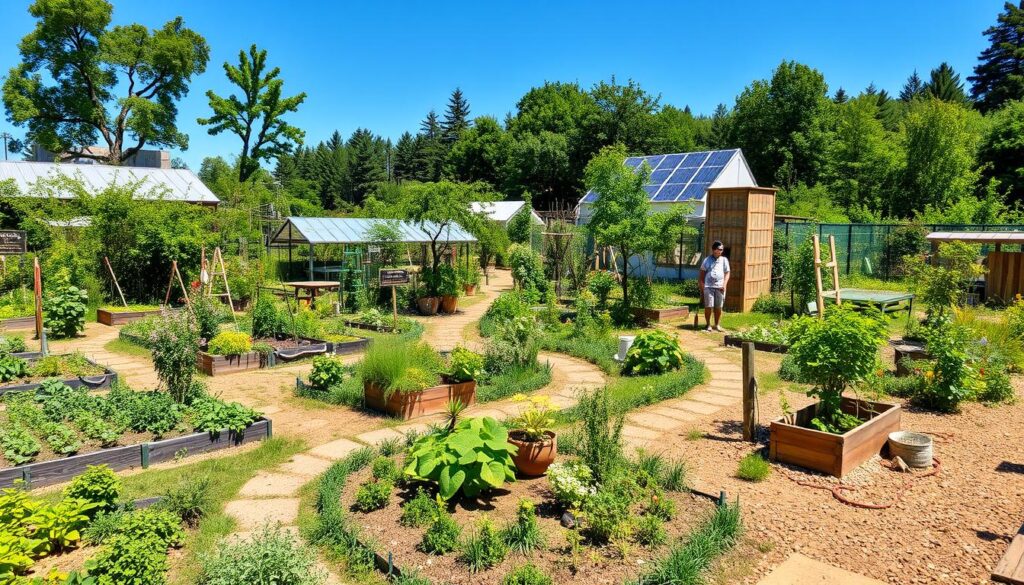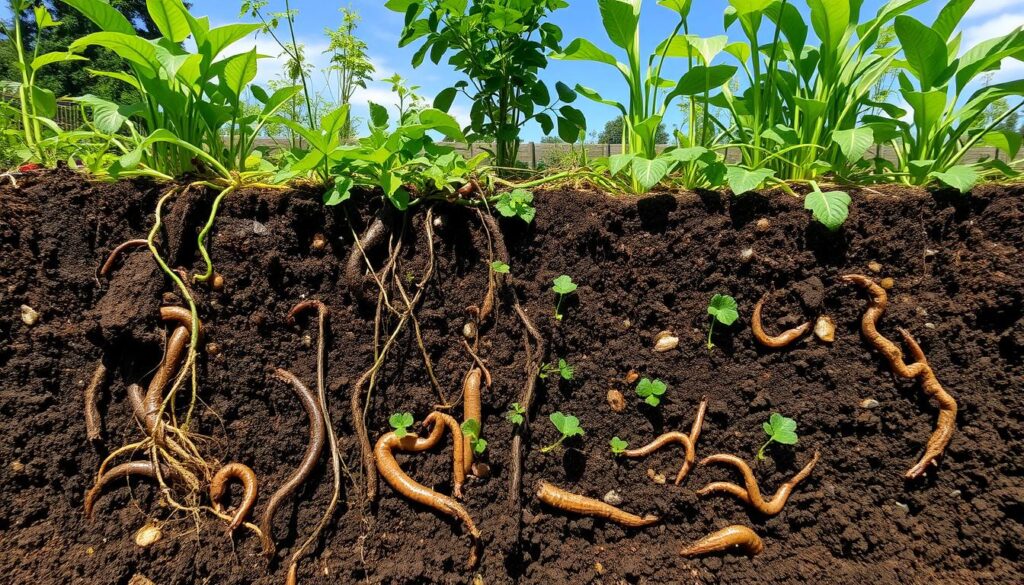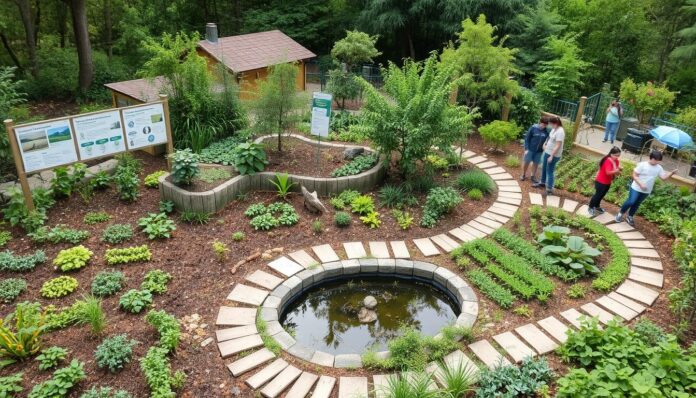Imagine a world where we live in harmony with nature. Permaculture education makes this dream possible. It teaches us how to live sustainably and connect with the earth. The Permaculture Education Institute, led by Morag Gamble, offers courses and workshops for all.
Learning permaculture is more than just gaining skills. It’s about building a community that wants to live sustainably. The Occidental Arts & Ecology Center is a great example. It has an 80-acre site where people learn about water systems, carbon cycling, and more.
By joining permaculture field training and courses, you can learn to create your own sustainable sites. This way, you can help your community live more sustainably.
Key Takeaways
- Permaculture education promotes sustainable living and connects people with the environment
- Permaculture field training and sustainable agriculture courses are available for individuals to learn permaculture principles and practices
- The Permaculture Education Institute offers a range of courses and workshops that cater to different needs and interests
- Creating permaculture demonstration sites can promote community engagement and education
- Permaculture education can be applied in real-life settings, such as the Occidental Arts & Ecology Center
- Participating in permaculture field training and sustainable agriculture courses can help individuals gain the knowledge and skills needed to create their own permaculture demonstration sites
Understanding Permaculture Principles
Permaculture is a way to design sustainable ecosystems. Mark Krawczyk says it’s more like guidelines than strict rules. This is key in workshops on regenerative farming, where people learn to manage ecosystems well.
Learning about ecological design is crucial in permaculture. It helps people see how living systems are connected. This way, they can design solutions that work with nature. By using permaculture, people can make ecosystems that are good for the environment and for us.
What is Permaculture?
Permaculture is a design system that works with nature to create sustainable ecosystems. It aims to make ecosystems that are productive, diverse, and resilient. These ecosystems offer many benefits for the environment and for people’s well-being.
Core Tenets of Permaculture
The core of permaculture includes caring for the earth, people, and sharing what you have. These principles help create sustainable, regenerative, and resilient ecosystems. By following these, people can make ecosystems that are better for the soil, have more biodiversity, and offer more ecosystem services.
Benefits of Permaculture Practices
Permaculture practices have many benefits. They improve soil health, increase biodiversity, and enhance ecosystem services. Permaculture also supports sustainable living, regenerates ecosystems, and benefits human well-being. By joining workshops and learning about ecological design, people can apply permaculture principles and create sustainable ecosystems.
| Permaculture Principle | Benefits |
|---|---|
| Caring for the earth | Improved soil health, increased biodiversity |
| Caring for people | Enhanced ecosystem services, improved human well-being |
| Sharing surplus | Regenerative ecosystems, sustainable living |
The Importance of Demonstration Sites
Demonstration sites are key in permaculture education. They offer hands-on training and show organic farming in action. These sites let people learn by watching and helping with sustainable practices.
The Whole Systems Design research farm, led by Ben Falk, is a great example. It offers workshops and practical experience in permaculture. Sites like this encourage community involvement and education. They help people start using sustainable practices at home.

Demonstration sites are great for learning by doing. They help spread sustainable practices and grow organic farming programs. This leads to a more eco-friendly and self-sufficient community.
Learning by Example
Learning by example is a big part of permaculture education. Demonstration sites offer a chance to see permaculture in action. By watching and helping, people learn about permaculture’s benefits and challenges. They also gain the skills and confidence to use these practices themselves.
Choosing the Right Location
Choosing the right location is key in permaculture. Ben Falk says climate, soil, and how easy it is to get to are important. A site assessment helps figure out these factors and make a good choice. Sustainable land management courses offer great advice on this.
When picking a spot, think about the microclimate, land direction, and water. For example, a spot with a gentle slope and faces south is great. But a steep, north-facing slope might not do well. Permaculture field training teaches how to handle these issues.
By looking at these factors and doing a site assessment, you can make smart choices. This is very important in rural areas. The right spot and training can lead to a successful permaculture system. This system supports sustainability and biodiversity.
Designing Your Permaculture Site
When designing a permaculture site, it’s key to think about water management and soil health. Mark Krawczyk’s method includes using natural features and making the most of space. This method is part of ecological design education, aiming for sustainable systems.
A good permaculture design boosts biodiversity and ecosystem services. It also offers chances for regenerative farming workshops and hands-on learning. Important things to consider include:
- Integrating natural features, such as slopes and water sources
- Utilizing space efficiently, through techniques like companion planting and crop rotation
- Creating a plan that promotes biodiversity and ecosystem services

By following these principles and thinking about your site’s unique features, you can build a thriving permaculture system. This system supports both people and the planet. Through ecological design education and regenerative farming workshops, you can learn the skills needed for a successful permaculture site.
Selecting Appropriate Plants
Choosing the right plants is key to a thriving permaculture ecosystem. It’s important to think about native vs. non-native species, edible vs. decorative plants, and ensuring biodiversity. Organic farming programs stress the need for plants that fit the local climate and soil.
Hands-on permaculture training offers valuable insights into picking the right plants. Native species, for example, can cut down on water and maintenance needs. They also boost biodiversity and ensure food all year round. Key things to consider when picking plants include:
- Soil preference (clay, silt, sand)
- Frost hardiness
- Resilience to moisture
By picking the right plants, permaculture practitioners can build a self-sustaining ecosystem. This ecosystem offers many benefits, like food, shelter, habitat, and ecosystem services.
The choice of plants is a vital part of permaculture design. It requires careful thought about many factors. By focusing on biodiversity, native species, and hands-on permaculture training, people can create ecosystems that benefit both humans and the planet.
| Plant Type | Benefits |
|---|---|
| Native Species | Promotes biodiversity, reduces water and maintenance needs |
| Edible Plants | Provides food, supports ecosystem services |
| Decorative Plants | Enhances aesthetic appeal, supports biodiversity |
Implementing Water Management Strategies
Effective water management is key in permaculture design. It includes using rainwater harvesting, swales, and contours. Ben Falk shows how these methods cut down on water waste and make water use more efficient. By taking sustainable land management courses, people can learn to use these strategies well.
Some important water management strategies in permaculture are:
- Rainwater harvesting techniques, like using harvesting drains to catch rainwater for irrigation
- Swales and contours, which slow down water and reduce soil loss, helping the ecosystem hold more water
- Drip irrigation systems, which save water and cut down on waste
Through permaculture field training, people can get practical experience in setting up effective water management systems. They learn about keyline design, contour mapping, and how to build up soil organic matter to improve water retention.
By using these water management strategies, people can make their permaculture systems more efficient and sustainable. This is done by combining sustainable land management courses and permaculture field training. This way, individuals get the knowledge and skills to create a successful permaculture system.
| Water Management Strategy | Description |
|---|---|
| Rainwater Harvesting | Collecting and storing rainwater for irrigation and other uses |
| Swales and Contours | Using swales and contours to slow down water and reduce soil loss |
| Drip Irrigation | Using drip irrigation systems to promote water efficiency and reduce waste |
Soil Health and Management
Soil health is key in permaculture design. Mark Krawczyk focuses on the soil’s structure, organic matter, and life. This knowledge helps in teaching ecological design and regenerative farming.
To keep soil healthy, use organic fertilizers and compost. Crop rotation and cover crops also help. These methods boost soil fertility and ecosystem resilience.
The Permagarden Approach highlights the need for living soils and good water management. Techniques like double digging enhance soil quality. These methods are vital in ecological design and regenerative farming workshops.

By focusing on soil health, we can build thriving ecosystems. These ecosystems support biodiversity and ecological balance. This leads to sustainable food systems and resilient communities, essential for a healthy planet.
| Soil Health Strategy | Description |
|---|---|
| Organic Fertilizers | Using natural materials to promote soil fertility |
| Composting Techniques | Converting organic waste into nutrient-rich soil amendments |
| Crop Rotation | Rotating crops to promote soil fertility and biodiversity |
Engaging the Community
Community engagement is key in permaculture education. It lets people learn from each other and work together. The Permaculture Education Institute, led by Morag Gamble, offers workshops, events, and courses. These organic farming programs and hands-on permaculture training sessions help people share their knowledge and skills.
Some examples of community engagement in permaculture education include:
- Hosting workshops and events to promote permaculture principles and practices
- Collaborating with local organizations to create opportunities for community engagement
- Involving schools and educational institutions to educate the next generation about sustainable living
Engaging the community makes permaculture education more impactful. Charles Williams and Starhawk, who have taught permaculture for over twenty years, say it’s important. They highlight the growth of interest in “social permaculture” as a key to a more sustainable and equitable society.

The benefits of community engagement in permaculture education are many, including:
| Benefit | Description |
|---|---|
| Knowledge sharing | Individuals can learn from each other and share their knowledge and skills |
| Collaboration | Community members can work together to create sustainable solutions |
| Education | Community engagement can educate individuals about sustainable living and permaculture principles |
Utilizing Technology in Permaculture
Technology is key in spreading the word about permaculture. The Permaculture Education Institute offers online courses and resources. These help people learn about permaculture and connect with others who share their interests.
Technology also helps with permaculture field training. Virtual tours let people see permaculture in action from anywhere. This is great for those who can’t make it to in-person training. Online platforms also connect learners with experienced permaculture practitioners.
Using technology in permaculture education has many benefits. It makes learning more accessible and affordable. People all over the world can learn about permaculture online. This helps grow permaculture communities and promote sustainable land management.
Monitoring and Maintenance
Effective permaculture design needs regular checks and upkeep to keep the ecosystem healthy and productive. This includes ecological design education and regenerative farming workshops to teach sustainable practices. By using these methods, people can build a strong and self-sustaining ecosystem that needs little outside help.
A good design can save time and money over time. The GOBRADIME design components offer a plan for a sustainable and regenerative ecosystem.
Some important things to think about for monitoring and maintenance are:
- Regular checks to find areas for betterment
- Long-term care plans to keep the ecosystem healthy
- Adjusting to climate and local changes to keep the ecosystem strong
By adding ecological design education and regenerative farming workshops to the design process, people can make a sustainable and thriving ecosystem. This ecosystem supports biodiversity and ecosystem services.
| Design Component | Description |
|---|---|
| Goals | Define the objectives and priorities of the design |
| Observation | Observe and record the patterns and relationships within the ecosystem |
| Boundaries | Define the physical and ecological boundaries of the design |
Success Stories from Around the World
Permaculture has been a hit globally, showing its power in making farming sustainable and building community. The Permaculture Education Institute has a list of top projects. For example, the Kusamala Institute in Malawi boosts farmer knowledge with its Red Soil Project.
In China, the Happy Food Farm teaches kids about permaculture. In New Zealand, the Koanga Institute has a huge seed collection and trains students and teachers. These efforts prove that organic farming programs and hands-on permaculture training can tackle food issues and support green living.
- The Ferme MiKu Valley Farm in Eastern Ontario, Canada, which covers an area of 68 acres and demonstrates sustainable farming practices.
- The Permaculture Institute of North America (PINA), which recognizes exceptional achievement through a certification process aimed at maintaining professional standards in permaculture design and practice.
These stories show how vital permaculture is for a greener future. They prove that organic farming programs and hands-on permaculture training can make a big difference.
Future Trends in Permaculture Demonstration
The world is waking up to the need for sustainable land management. Permaculture demonstration is set to change in exciting ways. New sustainable practices, policy support, and community backing will guide permaculture’s future.
New sustainable practices will lead the way. sustainable land management courses and permaculture field training will be key. These will show off new ways to harvest water, use renewable energy, and grow food sustainably. They will inspire people to live greener lives.
Policymakers and local leaders will play a big role. They will help create a space for permaculture to grow. With the right policies, money, and partnerships, permaculture can reach more people.
We see a future where learning is hands-on and interactive. Digital platforms will also play a part. The Permaculture Education Institute wants to give people the skills to build a better future.

